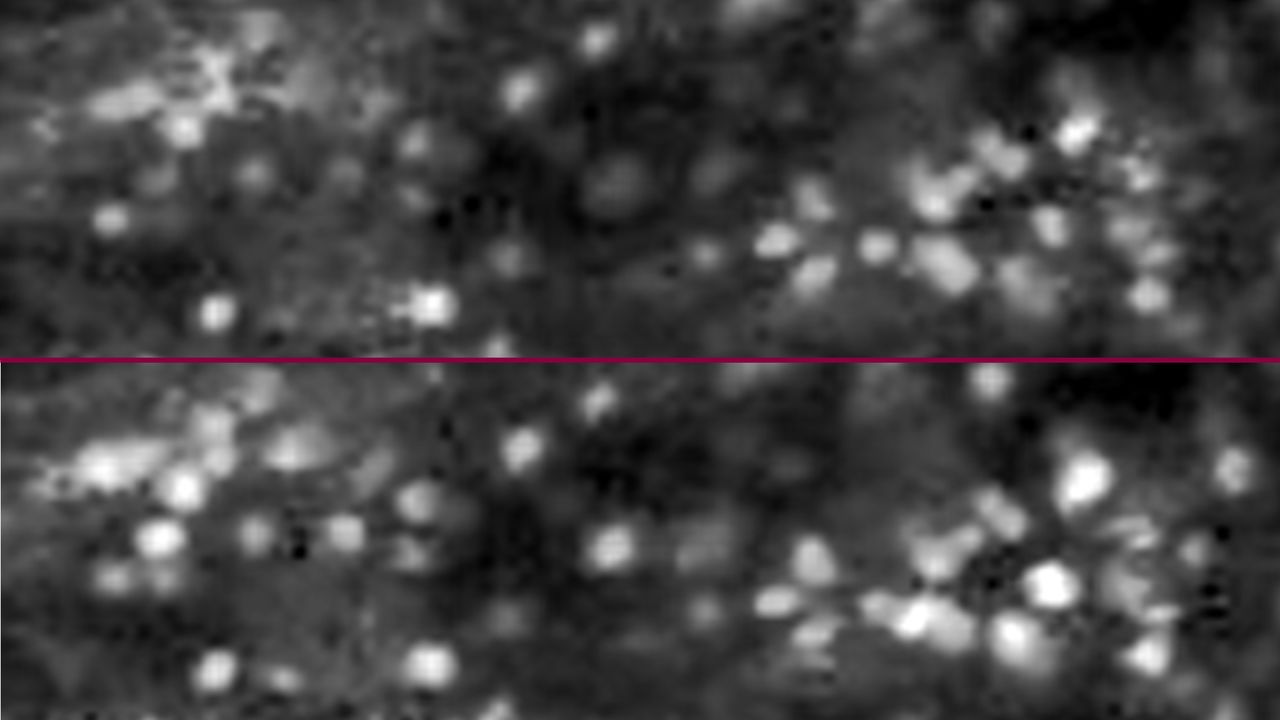研究成果 Research Results
- TOP
- News
- Research Results
- Nose’s response to odors more than just a simple sum of parts
Nose’s response to odors more than just a simple sum of parts
Recording of olfactory sensory neurons in mice shows suppression or enhancement of response when odors are mixed 2020.09.18Research ResultsLife & Health

Changes in the activity of olfactory sensory neurons in the nose of a mouse before (top) and after (bottom) an odor is introduced have been recorded as changes in light intensity.
Take a sniff of a freshly poured glass of wine, and the prevailing scientific thinking would suggest that the harmony of fragrances you perceive starts with sensory receptors in your nose simply adding up the individual odors they encounter. However, new research from Kyushu University shows that a much more complex process is occurring, with some responses being enhanced and others inhibited depending on the odors present.
In mammals, the sense of smell starts with the detection of odors by receptors at the ends of special cells—called olfactory sensory neurons—in the nose. Each of these neurons has just one type of receptor out of a large repertoire that depends on the species, with humans having around 400 types and mice around 1,000.
While the brain’s processing of sensory information is known to be important for picking out and synthesizing smells, relatively little is still known about the processes happening where the odors are first detected in the nose.
Using recently developed techniques for highly sensitive recording of the response of the receptors in the noses of living mice, the research group led by Takeshi Imai, professor in the Graduate School of Medical Sciences at Kyushu University, has now published in Cell Reports a deeper understanding of how neurons in the nose react to odors and their mixtures.
“It has been previously considered that each odor ‘activates’ a specific set of receptors, and that the response of neurons in the nose to odor mixtures is a simple sum of the responses to each component, but now we have evidence in mice that this is not the case,” says Shigenori Inagaki, the lead author of the paper.
Studying mice that were genetically modified to have their neurons emit green light depending on the amount of calcium ions in them—an indicator of activity—upon absorption of excitation light, the researchers were able to sensitively record the response of the neurons in the mice’s noses using a two-photon microscope.
Based on these recordings, Imai’s team found that odors could not only activate but also suppress the response of the neurons in the noses of mice, indicating complex interactions are happening well before the signals reach the olfactory bulb or brain for additional processing. Furthermore, their experiments showed that mixing of odors often leads to an enhancement of response through synergy, especially when they are in relatively low concentrations, or a suppression of response through antagonism, especially when they are in high concentrations.
The suppression and enhancement processes revealed by this study may explain why odor mixtures produce very different perceptual outcomes from their components, and this kind of understanding could aid in the development of methods for the rational design of olfactory experiences, from pleasant, harmonious smells to deodorizers.
“These results indicate that our perception of odors is being tuned from the very moment they are detected in the nose,” explains Imai. “Possibly, these findings may explain how the addition of a minor amount of an odor can have such a major effect on the perceived fragrance, or how different kinds of odor molecules in a glass of wine produce a nice harmony.”
###
For more information about this research, see “Widespread inhibition, antagonism, and synergy in mouse olfactory sensory neurons in vivo,” Shigenori Inagaki, Ryo Iwata, Masakazu Iwamoto, and Takeshi Imai, Cell Reports (2020). https://doi.org/10.1016/j.celrep.2020.107814
Research-related inquiries
Takeshi Imai, Professor
Faculty of Medical Sciences
Contact information can also be found in the full release.
- TOP
- News
- Research Results
- Nose’s response to odors more than just a simple sum of parts































